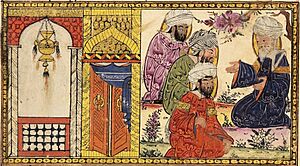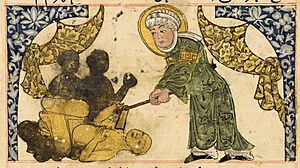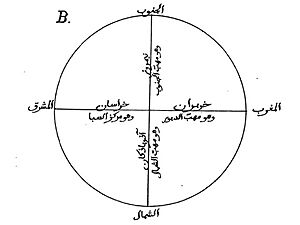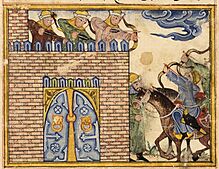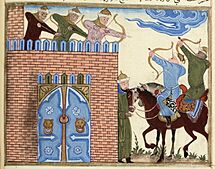The Remaining Signs of Past Centuries facts for kids
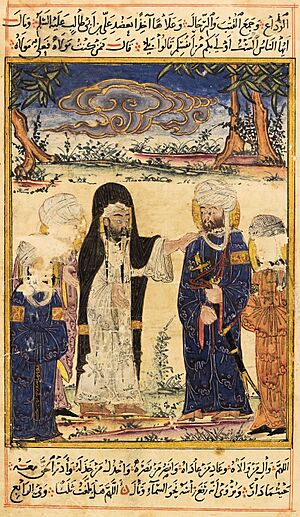
The Investiture of Ali at Ghadir Khumm, northern Iraq or northwestern Iran, 1307-08 (Edinburgh University Library, MS Arab 161, fol. 162r).
|
|
| Original title | کتاب الآثار الباقية عن القرون الخالية |
|---|---|
The Remaining Signs of Past Centuries (Arabic: کتاب الآثار الباقية عن القرون الخالية ) is an amazing book by Abū Rayhān al-Bīrūnī. It is also known as Chronology of Ancient Nations. This book looks at how different cultures and civilizations kept track of time using calendars. Al-Biruni used math, astronomy, and history to explore this topic.
The book creates a timeline of important historical events. It also explains the customs and religions of various people throughout history. When it was published around 1000 AD, it became a key reference for the history of Muslim lands. Al-Biruni wrote this major work in Gorgan when he was in his late twenties. He dedicated it to Qabus, who was the ruler of Gorgan at that time.
Contents
Amazing Old Copies of the Book
The Remaining Signs of Past Centuries exists in two special old copies. These are called illuminated manuscripts. They are found in the Edinburgh University Library (MS Arab 161) and the Paris Bibliothèque nationale de France (MS Arabe 1489).
The Edinburgh Copy: A Masterpiece
The Edinburgh copy was made by Ibn al-Kutbi in 1307–1308 AD. It was created in northwestern Iran or northern Iraq. This copy has 179 pages and 25 beautiful paintings. The first page and other pictures are very colorful and have real gold on them. This manuscript is seen as a great example of medieval Persian book art.
The Paris Copy: A Close Match
The Paris manuscript is a very similar copy of the Edinburgh book. It was made during the Ottoman period. Unlike the Edinburgh copy, we don't know who made it or exactly when.
Pictures That Tell Stories
The pictures in the book are placed carefully to show what the Ilkhanids (a group of rulers) were interested in. They were curious about religions other than Islam, which was the main religion. Many pictures show scenes from Zoroastrianism, Manichaeism, Buddhism, Judaism, and Christianity. Other pictures show interest in history and science.
For example, there's a picture of Julius Caesar's birth, showing a cesarean section. There's also a scene about the death of Eli and how Jewish people reacted. Another shows an Arab group listening to the Prophet Muhammad.
Persian Pride in the Art
The way the pictures frame the text makes foreign cultures seem important. But the book still shows strong Iranian national feelings. Ibn al-Kutbi, who made the Edinburgh copy, often included people from the Shahnama (a famous Persian epic poem). He also showed Persian festivals and times when Persians fought against foreign powers. This shows his love for his country.
Art Styles: Old and New
The images mix old Persian art styles with Chinese styles. The Chinese style came to Persia with the Mongol invasions. Out of 25 pictures, two look purely like old Persian art. Nineteen are a mix but mostly old Persian style. Four are a mix but look more like the new Mongol-influenced style.
Old Persian pictures were often placed randomly on the page. Mixed-style pictures often have a frame around them. Old Persian images usually showed figures in a flat way. Mixed images, however, showed more depth and complexity. The pictures in The Remaining Signs of Past Centuries also show different cultures in detail. This is because Al-Biruni did a lot of research on different ethnic groups. He traveled and wrote detailed descriptions of various groups.
Important Religious Scenes
The last two pictures in the book are the largest and most detailed. They show two important events in the life of Muhammad. Both scenes involve `Ali, Hasan, and Husayn. These are:
- The Day of Cursing (on page 161r)
- The Investiture of `Ali at Ghadir Khumm (on page 162r)
The Edinburgh manuscript has five pictures of Muhammad. One of the first shows the Prophet stopping a practice called Nasīʾ (on page 6v). These pictures are some of the earliest paintings of Muhammad in Persian art.
What the Book is About
In The Remaining Signs of Past Centuries, Al-Biruni shares his ideas about history. He sees history through a scientific lens. He starts by explaining why history, geography, and understanding different civilizations are important. He believes we need to study various cultures to truly understand the world.
A Timeline of Civilizations
The book gives a timeline of historical events. It focuses on how civilizations, rulers, and empires rose and fell. Al-Biruni writes about ancient groups like the Greeks, Romans, Persians, and Indians. He looks at history by analyzing why events happened and what their effects were. He mentions the birth and death of important figures like the Caliphs, Shia Imams, Fatimah (Muhammad's daughter), and Khadija (Muhammad's wife).
The book also describes the cultural practices, customs, and traditions of these societies. Al-Biruni explores topics like religion, language, art, and science. He shows how rich and diverse human culture is.
Science and Math in History
Al-Biruni was a polymath, meaning he was good at many subjects. He was very interested in science and astronomy. In his book, he talks about the most important scientific ideas, observations of stars, and math concepts of his time. He discusses the astrolabe, a tool used for astronomy. He also describes new ways to draw maps, which are now called the azimuthal equidistant and the Nicolosi globular projections. He combines this scientific knowledge with historical and cultural facts.
How Al-Biruni Studied History
A special part of the book is Al-Biruni's method for writing history. He stresses the importance of:
His careful way of working set a high standard for future scholars in history, geography, and anthropology.
Different Versions of the Book
(Or Ms 161)
(Arabe 1489)
The book has been published in different versions over time.
- C. Eduard Sachau edited an Arabic version in 1878.
- Sachau also translated the book into English in 1879. This English version is called The Chronology of Ancient Nations. It has been reprinted many times since then.


